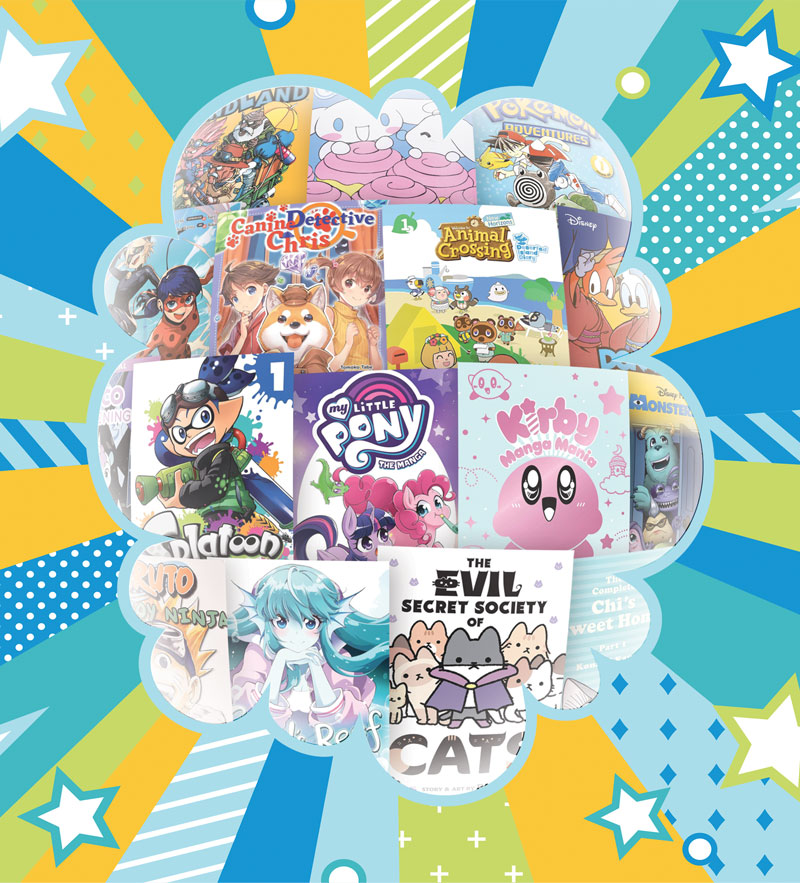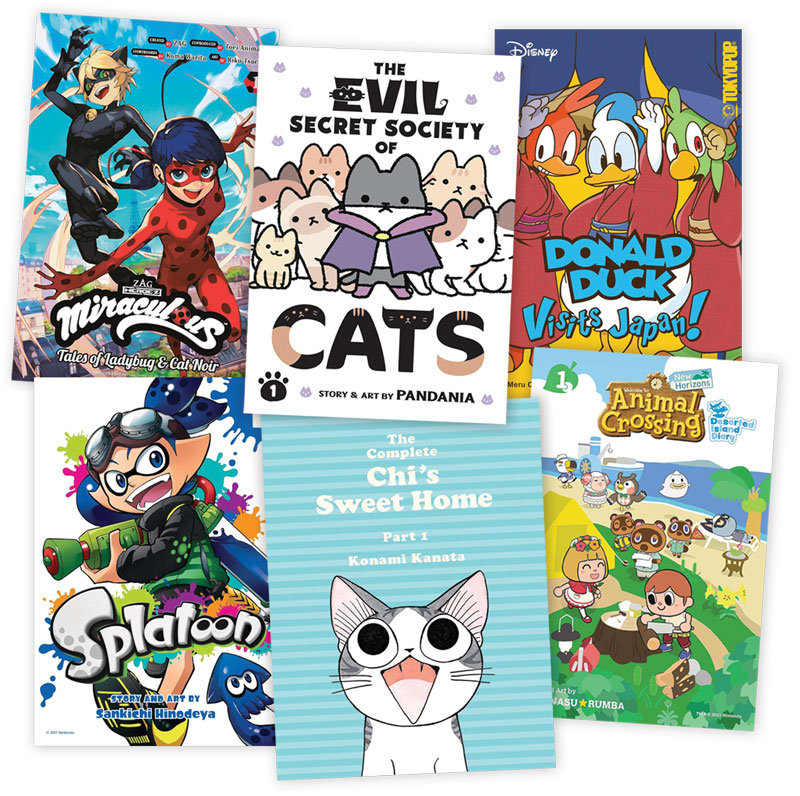There’s Not Enough Middle Grade Manga. U.S. Publishers Are Changing That.
U.S. publishers step up to provide age-appropriate new releases for 8- to 12-year-olds.

Related reading: |
Manga has never been more popular, and the variety never greater. But there’s one group of readers that is still underserved: children! The English-language manga market is dominated by teen and adult series, but middle graders and younger kids want their manga, too, and they don’t have enough to choose from.
Things are beginning to change, if slowly, and American publishers are playing a key role. In October, Scholastic announced that it would add manga to its Graphix imprint. “We want to do kid-friendly manga that feels like it’s right for the age group we publish for, particularly that 8-to-12-year-old group,” says Graphix publisher and cofounder David Saylor. Other publishers are stepping up, too, navigating challenges related to translation, ratings, and other issues to bring kids the age-appropriate manga they crave.
Gimme my manga!
Librarians are keenly aware that middle grade readers crave manga. “My students literally pull open my return bin to climb in to get manga when they see their classmates return it, just like they do for ‘Dog Man,’” says Ashley Hawkins, school librarian at PS 137 Rachel Jean Mitchell, a PK–5 school in New York City.
Lisa Rowland, media specialist at Jenks Freshman Academy High School in Oklahoma, constantly gets requests for manga recommendations from librarians serving younger grades. “There is a large demand [there], and the few manga that they do have constantly fly off of the shelves. They’re always looking for more,” she says.
Librarians keep an eye out for new material but want more. “Aside from a few new titles like ‘Kirby’ and ‘Animal Crossing,’ not much new is getting published,” says Rachel Forbes, customer information specialist at the Oakville Public Library in Ontario, Canada. As a result, “kids are definitely reading up.” When a third-grade class visited her library recently, Forbes grabbed volumes of “Naruto” and “My Hero Academia” from the teen collection to fill their requests.
Joe Pascullo, YA librarian at the New York Public Library, sees tweens making a beeline for his manga section as well. “They know the teen titles; they’re typically the ones made most visible thanks to anime adaptations shown on streaming services and the like,” he says.
In addition, “my students are often asking about older teen series,” Rowland says. “I have to be very aware of the content.”
Teen-rated manga titles often include material that’s not appropriate for younger readers, and series that seem kid-friendly at the start may increase the violence or sexual content in later volumes. When a group from a K–8 charter school visited Pascullo’s library, the school asked for the young adult team because they wanted to focus on anime and manga. While the visit was a success, Pascullo says, “It’s almost as if the children’s team of the library is stereotyped [as if] they only deal with super young kids…and don’t know anything about manga.”
A supply side shortage
The main hurdle at the moment is that much of what is produced in Japan doesn’t translate well. “There are things that are made for kids, but there’s not a huge amount of it that is both easy to translate for an American market in a satisfying way and doesn’t have too many cultural differences that make it difficult to translate,” Saylor says.
Denpa publisher Ed Chavez, who licensed “Chi’s Sweet Home” when he was at Vertical (a Kodansha imprint), has a similar opinion. “The comics themselves are often extremely busy, full of slapstick and potty humor, often relying on memes and pop cultural references that may not easily cross the Pacific Ocean for the casual manga/anime fan, let alone new readers—and/or their parents,” he says.
Even manga made for children often include body humor and sexual innuendoes that American audiences don’t expect to find in kids’ comics. That was an issue for Erik Ko of Udon Entertainment when he started a line of children’s manga in 2009. On a recent trip to Japan, he asked several publishers if they had considered toning down the content to make their manga easier to export. “Practically everyone told me no,” he says. “Some said, ‘We do take it into consideration, but first and foremost, we are creating content for Japan.’”
 |
Recent offerings from U.S. publishers |
The ratings question
Ironically, many series rated All Ages in the United States were originally published in manga magazines for adults in Japan. While children aren’t the target audience for these, they are free of sex and violence and often have cute characters, short chapters, and simple storylines.
“In Japan, there are only two age ratings for manga,” says Ben Applegate, director of the Kodansha manga editorial team at Penguin Random House Publisher Services. “There’s 18+ and there’s unrated.” So while Japanese publishers may include nudity in manga intended for children, they also produce wholesome content such as “Chi’s Sweet Home” for adult readers.
American manga publishers do assign age ratings, usually All Ages, Teen (13+), Teen+ (16+), and Mature (18+). These are not based on reading level, but on the amount of sex and violence, if any, in a series. Kodansha is adding another rating, All Ages 8+. “That is used on books that have content appropriate for all ages, but that kids younger than eight might not really be interested in reading,” Applegate says. “They might not get it.”
Age ratings aren’t always consistent from publisher to publisher, either. Viz’s ratings are fairly conservative, says vice president of publishing Kevin Hamric, in part because the publisher is aware that children read up. Ratings may also vary from volume to volume if series get more intense as they go along. Publishers must decide whether to assign a higher rating to the first few volumes of a series to keep it consistent, or simply rate volumes individually.
Applegate acknowledges that inconsistency can be frustrating for librarians, and it’s something he tries to avoid, usually by assigning the higher rating at the series’ start if he feels it will go that way. Sometimes he turns out to be wrong. “In some cases, we have reprinted volume ones with a lower rating,” he says.
Like many librarians, Sara Smith, the district librarian for a rural California school district, doesn’t take the ratings at face value. “There are some series that get older age ratings for who knows what reasons,” she says. “I read them and can’t figure out why they’re Teen, so we buy them for the library.”
Rowland reads the first volume of every series and then keeps an eye on ones that may skew older. “It’s a lot of work,” she says, “but graphic novels are over 40 percent of my checkouts, second only to fiction, and much of that is manga.”
To market, to market
To some extent, the lack of manga for pre-teens may reflect the fact that they have plenty of other options. “There’s a huge middle grade market for graphic novels in English, but that’s already—very successfully!—being served by English-original work with particular focuses, marketing, and sales channels,” says Seven Seas publisher Lianne Sentar. “When kids graduate from that, they tend to move to teen manga.”
Because the market evolved this way, most bookstores place their manga section in the adult area. Like the students Pascullo encountered, American readers don’t look for manga in the children’s section. Years ago, when Hamric persuaded Barnes & Noble to move Pokémon manga from the children’s section to the regular manga one, sales spiked. “We have that discussion with librarians a lot, too,” he says. “I always recommend that children’s manga should be in one specific area,” separate from the teen manga but apart from other graphic novels.
Expanding middle grade offerings
While the supply may not meet the demand yet, American publishers are doing their best to license titles for younger readers. All-ages, slice-of-life stories such as “Chi’s Sweet Home” and humorous titles such as “The Evil Secret Society of Cats” are popular with the youngest readers. The other big category is tie-ins to games and movies, such as “Animal Crossing,” “Splatoon,” “Miraculous: Tales of Ladybug & Cat Noir,” and Tokyopop’s large catalog of Disney manga.
As they continue the search for more middle grade manga to license, publishers are turning to other strategies to meet the demand. One is to keep older series such as “Sand Land” and “Fluffy, Fluffy Cinnamoroll” in print and make sure that librarians are aware of all the titles available. Hamric plans to distribute information about Viz’s all-ages titles at library events this year, and Kodansha has suggested titles on the Librarians page of its website.
Light novels, which have artwork and storylines similar to manga, have become an enormously popular medium among teens and adults, and Yen Press recently launched four middle grade light novel series, including “Canine Detective Chris,” under its JY imprint. These are basically illustrated chapter books with a manga vibe. Viz also publishes “Naruto” and “Dragon Ball” chapter books for middle grade readers who want stories about the characters they see in anime.
Some U.S. publishers have experimented with creating their own manga-style graphic novels tailored to American audiences. While the manga fans of the early 2000s sternly rejected non-Japanese content, today’s readers are more open to it, especially since the advent of manhwa and webtoons. Seven Seas began as a publisher of original English language manga and continues to include those titles in its catalog, including their “My Little Pony” manga and the new series “Coral’s Reef.”
Others use a hybrid model. “Unico: Awakening,” the first Graphix manga, is based on Osamu Tezuka’s classic tale of a time-traveling unicorn, with some adaptations. “This is an unusual manga, in that it was originally published in the western comic style by Tezuka, so we’re following his original intention for it,” Saylor says. “It’s illustrated by Gurihiru, a famous Japanese illustrator team, and reimagined by Samuel Sattin, who understands the American and kids’ market, so it’s a good combination.”
Saylor is also looking for manga that can be licensed directly, but he’s running into the same problems as everyone else. “I think there are undiscovered gems,” he says, “but I [also] think we are going to have to partner with people to come up with things that will work best in the American market.” He is open to collaboration with Japanese publishers, because he sees what the librarians see: “If we provide readers with the right books for that age group, I think they’re going to gobble them up—just like they do with Graphix books.”
Brigid Alverson edits “Good Comics for Kids.”
Top Imagery: Background art by YOTUYA/Getty Images (modified)
RELATED
The job outlook in 2030: Librarians will be in demand
The job outlook in 2030: Librarians will be in demand
ALREADY A SUBSCRIBER? LOG IN
We are currently offering this content for free. Sign up now to activate your personal profile, where you can save articles for future viewing





Add Comment :-
Be the first reader to comment.
Comment Policy:
Comment should not be empty !!!